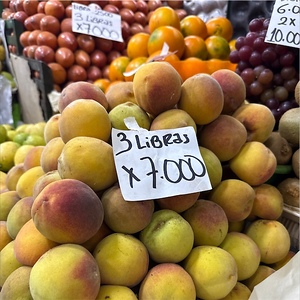


Chitagá Peaches
Estimated Inventory, lb : 0
Description/Taste
Chitagá peaches vary in size and shape, depending on the specific variety, and generally have a round to oblate shape with a slightly tapered, bluntly curved non-stem end. When ripe, the fruit showcases a golden yellow-orange coloring and is blushed with muted, dark red patches. The blush can be solid to transparent with some striping and varies based on the amount of sun exposure during cultivation. The skin is semi-thin, taut, and smooth, covered in a layer of soft, velvety fuzz. The skin also features a prominent suture line extending the fruit's length. Underneath the surface, the yellow-orange flesh is dense, fine-grained, aqueous, and succulent. There are also dark red patches in the flesh surrounding the central pit. Chitagá peaches are known for having a soft, delicate nature when ripe, making them prone to damage due to their melting consistency. The flesh also encases a central dark brown stone. Fay Elberta peaches are edible raw once ripe and emit a faintly sweet aroma. The flesh has a rich, refreshing, fruity, subtly floral, tangy, and sweet taste.
Seasons/Availability
Chitagá peaches are available year-round in Colombia.
Current Facts
Chitagá peaches, botanically classified as Prunus persica, are a category of peaches grown in Colombia belonging to the Rosaceae family. Several varieties of peaches are generally labeled under the Chitagá peach name, and Chitagá is the name of a municipality in the Norte de Santander department in Colombia. The two most popular varieties sold under Chitagá are Jarillo and Gran Jarillo Rojo peaches. These varieties are known for their productivity, with Gran Jarillo Rojo peach trees producing up to 700 kilograms of fruit in a single harvest. Peaches can also be cultivated year-round in Chitagá, allowing growers to stagger plantings for successive harvests to supply markets domestically and internationally. Chitagá peaches are savored as fresh-eating cultivars in commercial markets and are also sold to processing centers for peach-centric canned goods, beverages, and other products.
Nutritional Value
Chitagá peaches have not been studied for their nutritional properties. Peaches, in general, are a source of vitamins A, C, E, and K to strengthen the immune system, maintain healthy organs, aid in faster wound healing, and guard the cells against the damage caused by free radicals. Peaches also provide fiber to regulate digestion and minerals like potassium, copper, manganese, magnesium, phosphorus, calcium, and zinc. Potassium balances fluid levels within the body, copper helps produce red blood cells, and manganese contributes to energy production. Magnesium assists the body in controlling nerve functions, phosphorus and calcium support bones and teeth, and zinc helps with metabolism and making genetic material for cells.
Applications
Chitagá peaches have a sweet, tangy, fruity, and floral flavor suited for raw and cooked preparations. The fruits are typically consumed out of hand when ripe as a snack. When sold in commercial markets for fresh uses, Chitagá peaches are sliced and served on appetizer platters, tossed into salads, chopped into salsa, or used as a topping over oatmeal, yogurt, and puddings. Peaches are occasionally blended into smoothies, shakes, and various juices as a refreshing beverage. They are also pureed and frozen into popsicles and ice cream. In addition to raw preparations, Chitagá peaches are simmered into marmalades, jams, and other preserves or used as filling for tarts, crisps, crumbles, pies, and fritters. The fruits can be used in any preparation calling for yellow peaches and complement both sweet and savory dishes. Chitagá peaches can also be caramelized and topped with ice cream as a decadent dessert, roasted with meat dishes, or grilled for a smoky flavor. Chitagá peaches pair well with herbs like basil, cilantro, mint, and rosemary, ginger, vanilla, maple syrup, heavy cream, and fruits such as citrus, grapes, bananas, berries, and melons. Whole, unwashed Chitagá peaches should be ripened at room temperature. Once ripe, it is recommended to immediately consume the fruits for the best quality and flavor.
Ethnic/Cultural Info
Chitagá peaches are the signature crop of the Chitagá municipality in the department of Norte de Santander in Colombia. The region lies approximately 2,350 meters above sea level and is known for its cooler, temperate climate, ideal for peach cultivation. Peaches are grown for both processing and the fresh markets in Chitagá, and processed fruits are added to homemade goods to boost the region’s economy. Chitagá peaches are famously made into jams, preserved in syrups, infused into wine and beer, or added to cheese products. These goods are sold throughout Chitagá as a method to attract tourists, and the region has also developed a peach trail that visitors can follow throughout the municipality to learn about peach cultivation.
Geography/History
Chitagá peaches arose from South America sometime during the late 20th century. Peaches, in general, were introduced to parts of South America after the 16th century with European colonization. The fruit trees were planted in home gardens and were later cultivated as a fresh-eating and processing crop. Much of the Chitagá peach’s origin is unknown, but some sources claim the variety was derived from Venezuelan growers and planted in Colombia in the late 1990s. Chitagá is a term for multiple types of peaches grown in the Chitagá municipality in the department of Norte de Santander in Colombia. One of the first varieties planted under this name was the Jarillo peach, a cultivar known for its sweet taste and melting flesh. The variety succeeded in the region but proved too fragile for shipping and transporting to markets. A new variety was later introduced under the name Gran Jarillo Rojo with improved resilience during transportation, allowing it to become a widely cultivated peach for commercial sale. Today, Chitagá peaches are still comprised of the Gran Jarillo Rojo and Jarillo varieties and are sold domestically throughout Colombia. The peaches are also exported to other countries as fresh-eating fruits.








